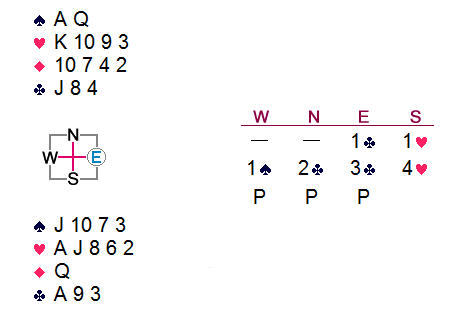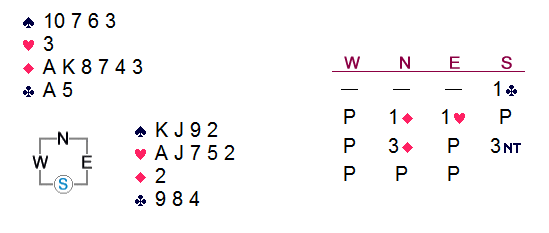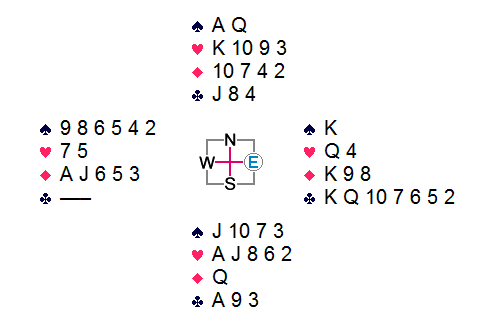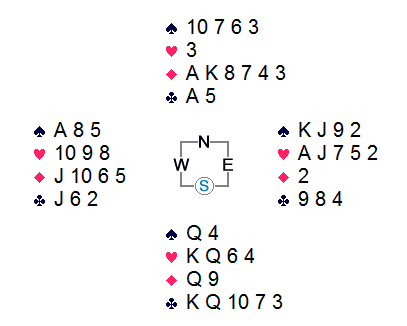

 |
 |
The Best and Worst Plays of 2007
The local Sectional tournament has just concluded — and not too soon for this reporter. My vote is in; although it is only May, there is a good chance that I already have seen the year's winning entries in two categories. As dummy on both occasions, I was the unwitting victim of both the best play of the tournament, and the worst.
I pose both situations as problems. Your first challenge arises early in the Swiss Teams:

The opening lead is the ace of diamonds, followed by another diamond to east's king. Plan the play.

The second problem is from the Saturday Pairs (rotated for convenience):

You are defending with the east cards. You partner dutifully leads the ten-spot of your bid suit. Plan the defense.
Details follow. Last chance to consider your plays.


Reasonable care garners no fewer than twelve tricks in this fascinating layout! In fact, on the presumption that west's failure to lead a club virtually guarantees a void and that east has some semblance of a real opening bid, the contract is virtually a sure thing except in the wildly unlikely case that east has all the missing trumps.
Should west have all the hearts, not only would she likely have doubled this
contract with Qxxx in trumps and a side ace opposite partner's opening
bid, but if she is 5-4-4-0, then it so happens that she has led the only card
that gives up the contract.
Interestingly enough, when no one shows out on the first trump lead, your contract becomes 100% safe against any distribution that includes a club void in west! You play a second heart to the king. If west shows up with three trumps, then you ruff a diamond to hand and take a spade finesse. That removes RHO's only entry, and he will be unable ever to win a club trick. West could ruff south's club ace, but dummy's other clubs eventually would disappear on the jack and ten of spades. The only losers would be one diamond, one spade, and one heart.
Alternatively, if east is holding queen-third of hearts, then he cannot have more than one spade; so you play off the ace and another spade, being prepared to lose a trick to west's king. The basic strategy is simply not to allow either defender to draw a third round round of trumps, which might leave you a trick short. You also must deny east the entries to score a club winner; that way, you always can win at least three spades plus either one club and six trump tricks, or no clubs and seven trumps.
Today, however, the outstanding trumps drop in two rounds. Recognizing that east could not have an opening bid without the spade king, you play spades from the top, considering it your due when the singleton king drops and you claim the remainder.

Ah, but that's not what actually happened at the table. After ruffing a diamond at trick two, our declarer tried a spade to the queen. The defenders grabbed the spade king, ruffed out the ace of clubs, ruffed a spade, cashed a club winner, then ruffed a club. When the smoke cleared, the contract was down three. This line of play also blew 21 imp, since a heart partial was played at the other table, scoring eleven tricks.
Justice was not served, however, as our team still won the match handily.

Had you looked at the printout for Board #27 from Saturday's final session, you might have noticed that the DeepFinesse analysis states that only eight tricks can be taken in notrump against best defense. Did you ask yourself why?

Our east player won the heart lead and placed the king of spades upon
the table! That enabled the defenders to take four spade tricks with the
aid of a finesse against dummy's ten-spot. After the heart lead,
east's textbook switch was the only way to defeat the contract.
(Yes, an opening lead of a low spade also would have worked.)
Well done by the east player! North and south could only congratulate the defenders, grit their teeth, and move on to the next board.
A little book-learning does help. So get back to your studies!